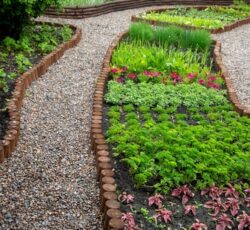 When planning and designing your outdoor space, why not consider incorporating edible plants into your landscape? Not only can they add beauty and visual interest, but they can also provide you with a bountiful harvest of fresh, homegrown produce. In this blog post, we will explore the benefits of incorporating edible plants into your landscape design and share some tips on how to do so effectively.
When planning and designing your outdoor space, why not consider incorporating edible plants into your landscape? Not only can they add beauty and visual interest, but they can also provide you with a bountiful harvest of fresh, homegrown produce. In this blog post, we will explore the benefits of incorporating edible plants into your landscape design and share some tips on how to do so effectively.
1. Enhancing Aesthetics with Edibles
Edible plants can be just as visually appealing as ornamental plants, if not more so. By integrating them into your landscape design, you can create a stunning and unique outdoor space. Consider the vibrant colors and interesting textures of plants such as Swiss chard, purple basil, or rainbow chard for a visually striking garden. Additionally, fruiting trees, like apple or cherry trees, can provide both beauty and a source of delicious produce.
2. Utilizing Space Effectively
Limited garden space doesn’t have to mean sacrificing your desire to grow your own food. Incorporating edible plants into your landscape can help you make the most of every square foot. You can use vertical gardening techniques, such as trellises or espaliered fruit trees, to save space and maximize productivity. Additionally, consider utilizing raised beds, containers, or even hanging baskets, which have the advantage of being movable and flexible in design.
3. Adding Ecological Benefits
Including edible plants in your landscape design can have positive ecological impacts. Natural pest control is enhanced when you grow a diverse range of plants. For example, marigolds can deter pests such as aphids, while certain herbs like rosemary can help repel mosquitoes. Additionally, edible plants can attract beneficial insects like bees and butterflies, promoting pollination and biodiversity in your garden.
4. Encouraging Sustainable Gardening
Growing your own food is an incredible step towards sustainable living. Incorporating edible plants into your landscape design allows you to practice sustainable gardening and reduce your ecological footprint. By growing your own produce, you can minimize packaging waste and reliance on pesticide-heavy store-bought food. Composting kitchen scraps can also contribute to the health and fertility of your garden.
5. Promoting Health and Well-being
Gardening is not only therapeutic but also a great way to improve your health and well-being. By growing edible plants, you are ensuring access to fresh, nutrient-dense produce right at your fingertips. This can lead to a healthier diet and an increased appreciation for the food you consume. Gardening is also known to reduce stress levels and promote physical activity, making it a beneficial hobby for overall well-being.
6. Ensuring Proper Care and Maintenance
When incorporating edible plants into your landscape design, it is important to consider their specific care requirements. Different plants have different needs, such as soil pH, sunlight exposure, and watering frequency. Be sure to research and select plants that are suitable for your climate and growing conditions. Plan your garden layout accordingly, grouping plants with similar needs together to make maintenance easier. Regularly monitor your plants for signs of pests or diseases and take appropriate measures to prevent or treat them.
7. Harvesting and Enjoying the Fruits of Your Labor
One of the most rewarding aspects of incorporating edible plants into your landscape is the opportunity to harvest and enjoy the fruits of your labor. As your plants grow and mature, you can look forward to picking fresh herbs, vegetables, and fruits from your backyard. From vibrant tomatoes in a salad to aromatic herbs in a homemade pesto, the possibilities are endless. Involve your family and friends in the harvesting process and delight in the satisfaction of eating homegrown produce.
Conclusion
Incorporating edible plants into your landscape design offers numerous benefits, from enhancing aesthetics to promoting sustainable living and improving health. By carefully planning your garden layout, considering the specific needs of your plants, and prioritizing proper care and maintenance, you can create a beautiful and productive outdoor space that serves both an ornamental and edible purpose. So, unleash your creativity, get your hands dirty, and enjoy the journey of incorporating edible plants into your landscape design.

